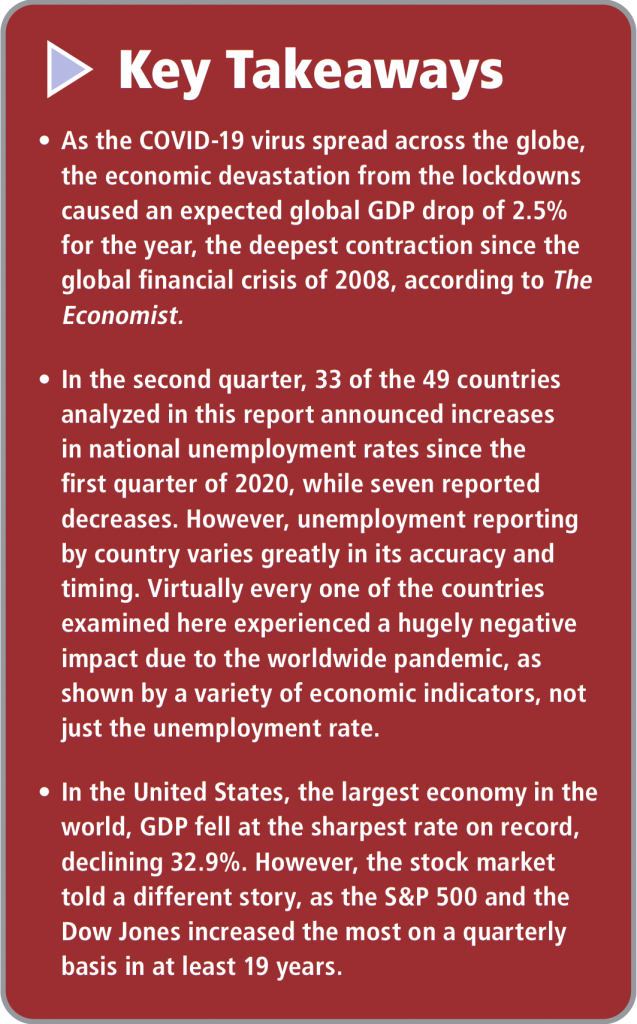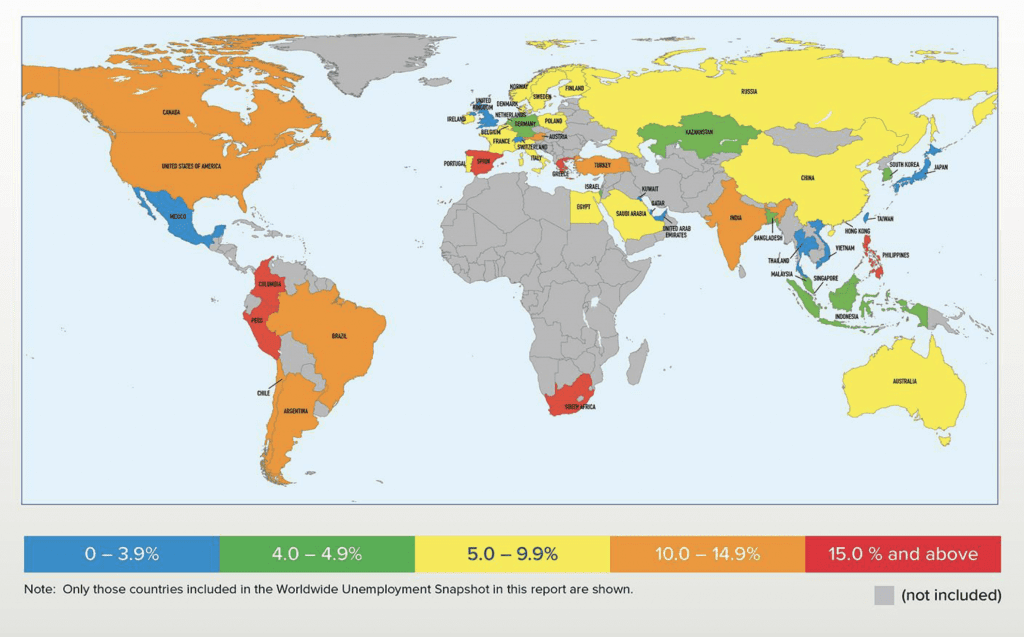The global pandemic continues to wreak havoc on world economy.
By Larry Basinait
Deploying a global workforce and ensuring access to the best talent is a crucial component of success for all multinational enterprises. Global labor market intelligence is an invaluable tool for these HR departments and can be used to inform critical decisions around the best countries and regions in which to grow.
To truly understand unemployment rates, it is necessary to collect several categories of market information about the overall economic environment from which they derive. For that reason, this global unemployment report also analyzes measures that include GDP, economic forecasts, and other factors that offer insight into a given country’s economic circumstances.
COVID-19 has delivered an enormous global shock, leading to steep recessions in many countries. The baseline forecast envisions a 5.2% contraction in global GDP in 2020 -the deepest global recession in decades, according to World Bank Group. Every developed country endured dramatic unemployment rate increases, as many businesses laid off or furloughed workers due to lockdowns and weak demand for products and services.
The direct economic impact of the pandemic has been largely felt within the second quarter as many countries did not implement lockdown restrictions until the middle or end of March. The decline in work hours in the second quarter is likely to be the equivalent to losing more than 300 million full-time jobs globally, according to the IMF.
The Eurozone will likely have a larger hit to its economy in 2020 than the United States, as the Eurozone economy is forecasted to contract by 10.2% versus only 8% contraction in the U.S., according to CNBC.
United States and Canada
As the consequences of COVID-19 continued to deepen across the United States, the economic fallout was at the forefront of business news. In the second quarter, over 30 million people filed for unemployment, by far the most in a single quarter. In the second quarter of 2020, the Worker Confidence Index decreased by 18.8 points from the first quarter of 2020 to 93.6, marking the third consecutive decline and a precipitous drop of 23.1 points in less than one year. In June, the U.S. unemployment rate increased by 6.7 percentage points from March to 11.1%, according to The Bureau of Labor Statistics.
The economic impact of the virus affected each state differently. Massachusetts had the largest increase in unemployment from the end of the first quarter to the end of the second quarter, up 14.5 percentage points to 17.4%, the highest of any state. Overall, there were five states with double digit increases in their unemployment rates on a quarter-over-quarter basis: Massachusetts, New Jersey, Hawaii, New York, and Michigan. California had the most job losses for the quarter, according to the National Conference of State Legislatures.
However, after a volatile first quarter of 2020 for the stock market, both the S&P 500 and Dow Jones Industrial Average had their best performance in at least 19 years. According to Yahoo Finance, the S&P 500 increased nearly 20% and the Dow Jones Industrials increased by over 17% on expectations that the economy would reopen from COVID-19 lockdowns and low interest rates.
As in the U.S., the Canadian economy contracted at the sharpest pace on record in the second quarter as most non-essential businesses shuttered, hammering economic activity. Moreover, retail trade in April had its sharpest contractions on record as consumer spending dropped precipitously. However, in May, the economy pointed to a slight rebound as production levels increased and retail sales surged. Due to the closure of non-essential businesses, the unemployment rate jumped to 12.3% in June, up 4.5 percentage points from March, according to FocusEconomics.
Asia-Pacific (APAC)
According to FocusEconomics, growth in the East and South Asia region slowed significantly in the second quarter of 2020 due to limited activity domestically and decreased demand for exports.
 China has by far the largest economy in the region with a GDP of $13.4 trillion. In the second quarter of 2020, the overall economy started to return to normalcy as many sectors started to reopen. Industrial production and investment activity both rebounded within the quarter. However, concerns of a second wave of COVID-19 along with the continued rippling effects of the pandemic weighed on consumer spending, according to FocusEconomics.
China has by far the largest economy in the region with a GDP of $13.4 trillion. In the second quarter of 2020, the overall economy started to return to normalcy as many sectors started to reopen. Industrial production and investment activity both rebounded within the quarter. However, concerns of a second wave of COVID-19 along with the continued rippling effects of the pandemic weighed on consumer spending, according to FocusEconomics.
The Japanese economy, the second largest in the region, contracted for the third consecutive quarter due to the national emergency that was declared between April and May for COVID-19. The decline was primarily caused by a fall in industrial production and a contraction in exports, finds FocusEconomics. The contraction in the economy let to a modest increase in the unemployment rate, up to 2.8% from 2.5% in the second quarter of 2020.
Europe, the Middle East, and Africa (EMEA)
In the second quarter of 2020, the Eurozone economy contracted the most on record, tumbling 12.1%, reports Yahoo Finance. As the lockdowns continued in the second quarter in many European countries, industrial production and retail sales dropped precipitously.
The United Kingdom has the second largest economy in Europe at $2.8 trillion dollars. In May, the service sector remained weak as it struggled to recover from the UK economy’s largest reported economic contraction on record in April, according to FocusEconomics. Moreover, since March, company payrolls have fallen by 730,000 people, the biggest drop in the number of working people in the UK since 2009, reports FocusEconomics.
Despite weak economic data, the unemployment rate improved slightly, down from 4% in the first quarter of 2020 to 3.9% in the second quarter of 2020. Germany has the third largest population in the region at 82.9 million, but by far the largest GDP ($4 trillion dollars). In the second quarter, the overall economy continued to contract as weakness in the manufacturing sector and weak foreign demand weighed on the economy. Due to the lack of consumer spending, the unemployment rate rose from 3.5% in the first quarter of 2020 to 4.2% in the second quarter of 2020, according to FocusEconomics.
Latin America
In the second quarter of 2020, Latin America’s largest economy, Brazil, reported an increase of 1.1 percentage points in its unemployment rate from the first quarter of 2020 to 13.3% in the second quarter of 2020. As social distancing and lockdown measures continued into the second quarter, the overall economy contracted again in the second quarter after shrinking at the sharpest pace on record in the first quarter of 2020. However, economic data released in May and June suggest that the economy may have bottomed out in April as the manufacturing and retail industries showed signs of improving, finds FocusEconomics.
Mexico is the second largest country in the region, both by GDP and population. Even after the economy shrank at the steepest rate in over a decade in the first quarter, many economic indicators point to a similar trend in the second quarter. The most recent unemployment data states that Mexico’s unemployment rate currently stands at 2.9%, according to Reuters.
Click here to access the entire Global Unemployment Report.













